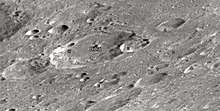Biela (crater)
Biela is a lunar impact crater that is located in the rugged highlands of the southeastern Moon. It is named after Austrian astronomer Wilhelm von Biela.[1] The crater lies to the east of Rosenberger, to the southeast of the Watt–Steinheil double crater.
 Lunar Orbiter 4 image | |
| Coordinates | 54.9°S 51.3°E |
|---|---|
| Diameter | 76 km |
| Depth | 3.1 km |
| Colongitude | 310° at sunrise |
| Eponym | Wilhelm von Biela |
The rim of this crater is overlaid by a pair of small but notable craters: Biela C across the northeast rim and Biela W along the western inner wall. The satellite crater Biela B is attached to the southwestern outer rim, and ejecta from Biela covers the northwestern part of the interior. Despite a certain degree of wear, the rim of Biela remains relatively well-defined, especially in the southeast.
The interior floor is flat and not marked by any craterlets of note. There is a central peak formation of three ridges located just to the northeast of the midpoint.
Satellite craters

By convention these features are identified on lunar maps by placing the letter on the side of the crater midpoint that is closest to Biela.
| Biela | Latitude | Longitude | Diameter |
|---|---|---|---|
| A | 52.9° S | 53.3° E | 26 km |
| B | 56.5° S | 49.6° E | 43 km |
| C | 54.3° S | 53.5° E | 26 km |
| D | 55.8° S | 56.3° E | 14 km |
| E | 56.4° S | 56.3° E | 8 km |
| F | 56.3° S | 54.5° E | 9 km |
| G | 56.2° S | 53.9° E | 10 km |
| H | 57.9° S | 54.2° E | 8 km |
| J | 57.0° S | 52.9° E | 14 km |
| T | 53.8° S | 49.9° E | 7 km |
| U | 53.4° S | 49.0° E | 16 km |
| V | 53.6° S | 48.5° E | 6 km |
| W | 55.1° S | 49.6° E | 16 km |
| Y | 54.9° S | 58.0° E | 15 km |
| Z | 53.8° S | 57.0° E | 48 km |
References
- "Biela (crater)". Gazetteer of Planetary Nomenclature. USGS Astrogeology Research Program.
- Andersson, L. E.; Whitaker, E. A. (1982). NASA Catalogue of Lunar Nomenclature. NASA RP-1097.CS1 maint: ref=harv (link)
- Bussey, B.; Spudis, P. (2004). The Clementine Atlas of the Moon. New York: Cambridge University Press. ISBN 978-0-521-81528-4.CS1 maint: ref=harv (link)
- Cocks, Elijah E.; Cocks, Josiah C. (1995). Who's Who on the Moon: A Biographical Dictionary of Lunar Nomenclature. Tudor Publishers. ISBN 978-0-936389-27-1.CS1 maint: ref=harv (link)
- McDowell, Jonathan (July 15, 2007). "Lunar Nomenclature". Jonathan's Space Report. Retrieved 2007-10-24.CS1 maint: ref=harv (link)
- Menzel, D. H.; Minnaert, M.; Levin, B.; Dollfus, A.; Bell, B. (1971). "Report on Lunar Nomenclature by the Working Group of Commission 17 of the IAU". Space Science Reviews. 12 (2): 136–186. Bibcode:1971SSRv...12..136M. doi:10.1007/BF00171763.CS1 maint: ref=harv (link)
- Moore, Patrick (2001). On the Moon. Sterling Publishing Co. ISBN 978-0-304-35469-6.CS1 maint: ref=harv (link)
- Price, Fred W. (1988). The Moon Observer's Handbook. Cambridge University Press. ISBN 978-0-521-33500-3.CS1 maint: ref=harv (link)
- Rükl, Antonín (1990). Atlas of the Moon. Kalmbach Books. ISBN 978-0-913135-17-4.CS1 maint: ref=harv (link)
- Webb, Rev. T. W. (1962). Celestial Objects for Common Telescopes (6th revised ed.). Dover. ISBN 978-0-486-20917-3.CS1 maint: ref=harv (link)
- Whitaker, Ewen A. (1999). Mapping and Naming the Moon. Cambridge University Press. ISBN 978-0-521-62248-6.CS1 maint: ref=harv (link)
- Wlasuk, Peter T. (2000). Observing the Moon. Springer. ISBN 978-1-85233-193-1.CS1 maint: ref=harv (link)
| Wikimedia Commons has media related to Biela (crater). |
